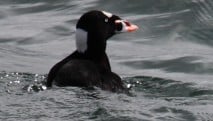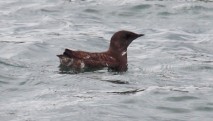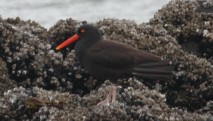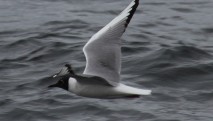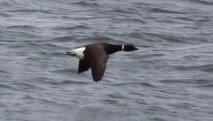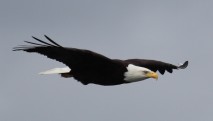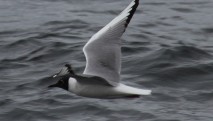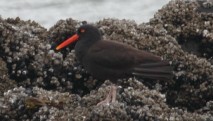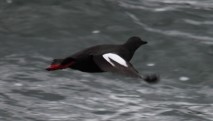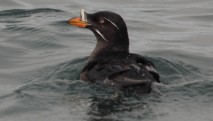Migrants of May (Photos courtesy of Jim Bachman)
What a beautiful day we had two weeks ago out on the Salish Sea. Our travels started out on the South side of Bellingham out of Fairhaven. We crossed Bellingham Bay heading south. Here we encountered dozens of Bonaparte’s gulls in their full breeding plumage. They are winter residents here and are probably now headed to the Arctic and parts of Northern Canada where they will breed and raise their chicks. Of course there were numerous Glaucous Wing Gulls, which are the only gulls who reside here year round.  There were also many Common Loons , Surf Scoters and Long-tailed Ducks (formerly known as Oldsquaw).  These birds spend their winters along our coastal regions, but will be heading to northern inland lakes to breed and nest. Some will migrate as far north as the Arctic.
As we headed towards the mudflats of Padilla Bay we saw huge flocks of Brant Geese flying in formations. These are primarily a sea goose and feed on aquatic plants of shallow bays and estuaries. The large eelgrass beds here provide food for them for their long journey to the Arctic.
The mudflats at the entrance to the Swinomish Channel afforded us views of hundreds of Great Blue Herons. There is a rookery nearby. Great Blue Herons are solitary creatures, yet congregate in large colonies when it is nesting time.
We had a delightful cruise through the Swinomish Channel and past the small town of La Conner. Since the weather permitted, we were able to go under the Deception Pass Bridge and cross Rosario Strait over to Lopez Island. There is an eagle’s nest on the south end of Lopez that we observed last year on our bird cruises. There was a pair of Bald Eagles there, so they have returned to nest and raise their young at this nesting site. Bald Eagle pairs will return to the same nesting site year after year.  Eagles will reside year round here, but many of them will migrate in the fall to the Nooksack and Skagit Rivers  to feed on salmon. Some will migrate as far north as the Chilkat River in Southeast Alaska.
The Alcids, such as Marbled Murrelets, Rhinoceros Auklets and Pigeon Guillemots will never be seen on land. They live their life on the water and come to land only to nest for a few short weeks in the spring in remote areas.
Being out on the water, we saw numerous harbor porpoise. They are the smallest porpoise and inhabit our coastal regions. They are quite numerous here and swim in small pods. They are one of the smallest cetaceans in the world and are found throughout the northern hemisphere in temperate waters.
On the rocky islets throughout the Salish Sea are places where harbor seals haul out. There were large congregations of them lounging on the rocks warming up in the sun as we passed by. They are pretty indifferent to boat traffic and we were able to get some good views. Pupping season will start next month and we will be able to see the small pups with their moms.
Next month we will be heading to Sucia and Patos Islands where there are nesting sites for the Pigeon Guillemots. We will also see the other members of the Alcid family, as well as many of these other birds on the species list. There will also be new additions as birds migrate here to spend the summer.
Our next trip is June 7th. We have also added an extra trip on June 8th, since our Saturday trip was sold out. Â Come out with us and help us expand our species list for the summer! The more eyes the better!
Following is a species list of the birds we were able to see on this first bird cruise of the year.
Surf Scoters
Common Loons
Brant’s  Sea Goose
Pelagic Cormorants
Doublecrested Cormorants
Brandt’s Cormorant (1)
Rhinoceros Auklets
White Fronted Goose
Barn Swallows
Cliff Swallows
Western Sandpipers
Turkey Vulture
Bald Eagle
Harlequin Ducks
Black Oystercatcher
Pigeon Guillemotts
Glaucous Wing Gulls
Bonaparte’s Gulls
California Gulls
Mew Gull
Great Blue Herons
Long –tailed Duck
Caspian Terns
American Robin
American Goldfinch
Rufous Hummingbird
Marbled Murreletts
Northwestern Crow
Belted Kingfisher

